Study of a Novel Method to Weaken the Backmixing in a Multi-Inlet Vortex Mixer
Abstract
1. Introduction
2. MIVM Domain and Numerical Method
2.1. Simulation Domain
2.2. Materials and Operating Conditions
2.3. Numerical Models
3. Results and Discussion
3.1. Simulation Validation
3.2. Residence Time of Fluid
- (1)
- There were multiple peaks appearing earlier than the average residence time, indicating that there may have been multiple short-circuit flows.
- (2)
- After the appearance of the maximum concentration on the RTD curve, the descending curve was not smooth, which showed that there may have been backflow.
- (3)
- There was an obvious tailing on the curve, which indicated the existence of backmixing in the mixer.
- (1)
- The peak of the RTD curve appeared later and was closer to the average residence time.
- (2)
- The RTD curve ascended and descended more rapidly near the peak.
- (3)
- On RTD curve, the multi-peak phenomenon was almost eliminated.
3.3. Tanks-in-Series Model
3.4. Turbulent Energy Dissipation
4. Conclusions
Author Contributions
Funding
Data Availability Statement
Acknowledgments
Conflicts of Interest
Abbreviations
| Nomenclature | |
| k | Turbulent kinetic energy, m2·s−2 |
| ω | Specific energy dissipation rate, s−1 |
| Win | Width of the inlet, mm |
| Lin | Length of the inlet, mm |
| Dout | Diameter of the outlet pipe, mm |
| Lin | Length of the outlet pipe, mm |
| Hmix | Height of the mixing chamber, mm |
| Dmix | Diameter of the mixing chamber, mm |
| Re | Reynolds number |
| N | Number of columns |
| ΔL | Axis distance between the center of column and center of mixer, mm |
| φ | Diameter of the column, mm |
| θ | Angle of rotation around the center, ° |
| μt | Turbulent eddy viscosity, kg·m−1·s−1 |
| Pk | Generating term of the turbulent kinetic energy, kg·m−1·s−3 |
| ρ | Fluid density, kg·m−3 |
| U | Fluid velocity, m·s−1 |
| μ | Fluid viscosity, kg·m−1·s−1 |
| hmax | Maximum edge length of the grid, mm |
| l | Length scale of the turbulent model, mm |
| S | Magnitude of the strain rate tensor, s−1 |
| Ω | Magnitude of the vorticity tensor, s−1 |
| dw | Distance from the grid to the nearest wall, mm |
| V | Volume of the cell, mm3 |
| vz | Axial velocity, m·s−1 |
| vt | Tangential velocity, m·s−1 |
| Q | Q criterion, s−2 |
| uij | ∂ui/∂xj, s−1 |
| uji | ∂uj/∂xi, s−1 |
| Abbreviations | |
| FNP | Flash nanoprecipitation |
| CIJ | Confined impinging jet |
| MIVM | Multi-inlet vortex mixer |
| CFD | Computational fluid dynamics |
| PIV | Particle image velocimetry |
| PLIF | Planar laser-induced fluorescence |
| SDES | Shielded detached eddy simulation |
| SST | Shear-stress transport |
| RANS | Reynolds-averaged Navier–Stokes |
| LES | Large-eddy simulation |
| DDES | Delayed detached eddy simulation |
| DES | Detached eddy simulation |
| RTD | Residence time distribution |
| COV | Coefficient of variation |
References
- Zhao, Y.B.; Qiu, Z.M.; Huang, J.Y. Preparation and analysis of Fe3O4 magnetic nanoparticles used as targeted-drug carriers. Chin. J. Chem. Eng. 2008, 16, 451–455. [Google Scholar] [CrossRef]
- Wicki, A.; Witzigmann, D.; Balasubramanian, V.; Huwyler, J. Nanomedicine in cancer therapy: Challenges, opportunities, and clinical applications. J. Control. Release 2015, 200, 138–157. [Google Scholar] [CrossRef] [PubMed]
- Xiao, S.Y.; Tang, Y.F.; Lv, Z.; Lin, Y.M.; Chen, L. Nanomedicine—Advantages for their use in rheumatoid arthritis theranostics. J. Control. Release 2019, 316, 302–316. [Google Scholar] [CrossRef]
- Wilson, B.; Geetha, K.M. Neurotherapeutic applications of nanomedicine for treating Alzheimer’s disease. J. Control. Release 2020, 325, 25–37. [Google Scholar] [CrossRef]
- Huo, M.F.; Wang, L.Y.; Chen, Y.; Shi, J.L. Nanomaterials/microorganism-integrated microbiotic nanomedicine. Nano Today 2020, 32, 100854. [Google Scholar] [CrossRef]
- Johnson, B.K.; Prud’homme, R.K. Flash nanoprecipitation of organic actives and block copolymers using a confined impinging jets mixer. Aust. J. Chem. 2003, 56, 1021–1024. [Google Scholar] [CrossRef]
- Valente, I.; Stella, B.; Marchisio, D.L.; Dosio, F.; Barresi, A.A. Production of PEGylated nanocapsules through solvent displacement in confined impinging jet mixers. J. Pharm. Sci. 2012, 101, 2490–2501. [Google Scholar] [CrossRef]
- Tao, J.S.; Chow, S.F.; Zheng, Y. Application of flash nanoprecipitation to fabricate poorly water-soluble drug nanoparticles. Acta Pharm. Sin. B 2019, 9, 4–18. [Google Scholar] [CrossRef] [PubMed]
- Shi, L.; Shan, J.N.; Ju, Y.G.; Aikens, P.; Prud’homme, R.K. Nanoparticles as delivery vehicles for sunscreen agents. Colloids Surf. A Physicochem. Eng. Asp. 2012, 396, 122–129. [Google Scholar] [CrossRef]
- Liu, Y.; Olsen, M.G.; Fox, R.O. Turbulence in a microscale planar confined impinging-jets reactor. Lab Chip 2009, 9, 1110–1118. [Google Scholar] [CrossRef]
- Liu, Y.; Cheng, C.Y.; Liu, Y.; Prud’homme, R.K.; Fox, R.O. Mixing in a multi-inlet vortex mixer (MIVM) for flash nano-precipitation. Chem. Eng. Sci. 2008, 63, 2829–2842. [Google Scholar] [CrossRef]
- D’Addio, S.M.; Prud’homme, R.K. Controlling drug nanoparticle formation by rapid precipitation. Adv. Drug Deliv. Rev. 2011, 63, 417–426. [Google Scholar] [CrossRef]
- Akbulut, M.; Ginart, P.; Gindy, M.E.; Theriault, C.; Chin, K.H.; Soboyejo, W.; Prud’homme, R.K. Generic method of preparing multifunctional fluorescent nanoparticles using flash nanoprecipitation. Adv. Funct. Mater. 2009, 19, 718–725. [Google Scholar] [CrossRef]
- Kumar, V.; Adamson, D.H.; Prud’homme, R.K. Fluorescent polymeric nanoparticles: Aggregation and phase behavior of pyrene and amphotericin B molecules in nanoparticle cores. Small 2010, 6, 2907–2914. [Google Scholar] [CrossRef] [PubMed]
- Shen, H.; Hong, S.; Prud’homme, R.K.; Liu, Y. Self-assembling process of flash nanoprecipitation in a multi-inlet vortex mixer to produce drug-loaded polymeric nanoparticles. J. Nanoparticle Res. 2011, 13, 4109–4120. [Google Scholar] [CrossRef]
- Liu, Z.P.; Hill, J.C.; Fox, R.O.; Olsen, M.G. Investigation of turbulent mixing in a macro-scale multi-inlet vortex nanoprecipitation reactor by stereoscopic-PIV. In Proceedings of the ASME 2014 4th Joint US-European Fluids Engineering Division Summer Meeting, Chicago, IL, USA, 11–15 July 2014. [Google Scholar]
- Liu, Z.P.; Ramezani, M.; Fox, R.O.; Hill, J.C.; Olsen, M.G. Flow characteristics in a scaled-up multi-inlet vortex nanoprecipitation reactor. Ind. Eng. Chem. Res. 2015, 54, 4512–4525. [Google Scholar] [CrossRef]
- Liu, Z.P.; Passalacqua, A.; Olsen, M.G.; Fox, R.O.; Hill, J.C. Dynamic delayed detached eddy simulation of a multi-inlet vortex reactor. AIChE J. 2016, 62, 2570–2578. [Google Scholar] [CrossRef]
- Liu, Z.P.; Hitimana, E.; Olsen, M.G.; Hill, J.C.; Fox, R.O. Turbulent mixing in the confined swirling flow of a multi-inlet vortex reactor. AIChE J. 2017, 63, 2409–2419. [Google Scholar] [CrossRef]
- Cheng, J.C.; Olsen, M.G.; Fox, R.O. A microscale multi-inlet vortex nanoprecipitation reactor: Turbulence measurement and simulation. Appl. Phys. Lett. 2009, 94, 204104. [Google Scholar] [CrossRef]
- Leon, M.A.; Nijhuis, T.A.; Schaaf, J.V.D.; Schouten, J.C. Residence time distribution and reaction rate in the horizontal rotating foam stirrer reactor. Chem. Eng. Sci. 2014, 117, 8–17. [Google Scholar] [CrossRef]
- Bhutto, R.A.; Bhutto, N.H.; Iqbal, S.; Manoharadas, S.; Yi, J.; Fan, Y.T. Polyelectrolyte nanocomplex from sodium caseinate and chitosan as potential vehicles for oil encapsulation by flash nanoprecipitation. Food Hydrocolloid 2024, 150, 109666. [Google Scholar] [CrossRef]
- Lass, H.U.; Mohrholz, V.; Knoll, M.; Prandke, H. Enhanced mixing downstream of a pile in an estuarine flow. J. Mar. Syst. 2008, 74, 505–527. [Google Scholar] [CrossRef]
- Dundi, T.M.; Raju, V.R.K.; Chandramohan, V.P. Characterization of mixing in an optimized designed T–T mixer with cylindrical elements. Chin. J. Chem. Eng. 2019, 27, 2337–2351. [Google Scholar] [CrossRef]
- Li, L.; Xu, W.X.; Tan, Y.F.; Yang, Y.S.; Yang, J.G.; Tan, D.P. Fluid-induced vibration evolution mechanism of multiphase free sink vortex and the multi-source vibration sensing method. Mech. Syst. Signal Process. 2023, 189, 110058. [Google Scholar] [CrossRef]
- Blevins, R.D.; Scanlan, R.H. Flow-induced vibration. J. Mech. Des. N. Y. 1977, 44, 802. [Google Scholar] [CrossRef]
- Travin, A.; Shur, M.; Strelets, M.; Spalart, P. Detached-eddy simulations past a circular cylinder. Flow Turbul. Combust. 1999, 63, 293–313. [Google Scholar] [CrossRef]
- Zhao, W.W.; Wan, D.C.; Sun, R. Detached-eddy simulation of flows over a circular cylinder at high Reynolds number. In Proceedings of the 26th International Ocean and Polar Engineering Conference, Rhodes, Greece, 26 June–1 July 2016. [Google Scholar]
- ANSYS Inc. ANSYS Fluent Theory Guide; ANSYS Inc.: Canonsburg, PA, USA, 2017. [Google Scholar]
- Gritskevich, M.S.; Garbaruk, A.V.; Schutze, J.; Menter, F.R. Development of DDES and IDDES formulations for the k-ω shear stress transport model. Flow Turbul. Combust. 2012, 88, 431–449. [Google Scholar] [CrossRef]
- Jeong, J.; Hussain, F. On the identification of a vortex. J. Fluid Mech. 1995, 285, 69–94. [Google Scholar] [CrossRef]
- Kuhnen, J.; Song, B.F.; Scarselli, D.; Budanur, N.B.; Riedl, M.; Willis, A.P.; Avila, M.; Hof, B. Destabilizing turbulence in pipe flow. Nat. Phys. 2018, 14, 386–390. [Google Scholar] [CrossRef]

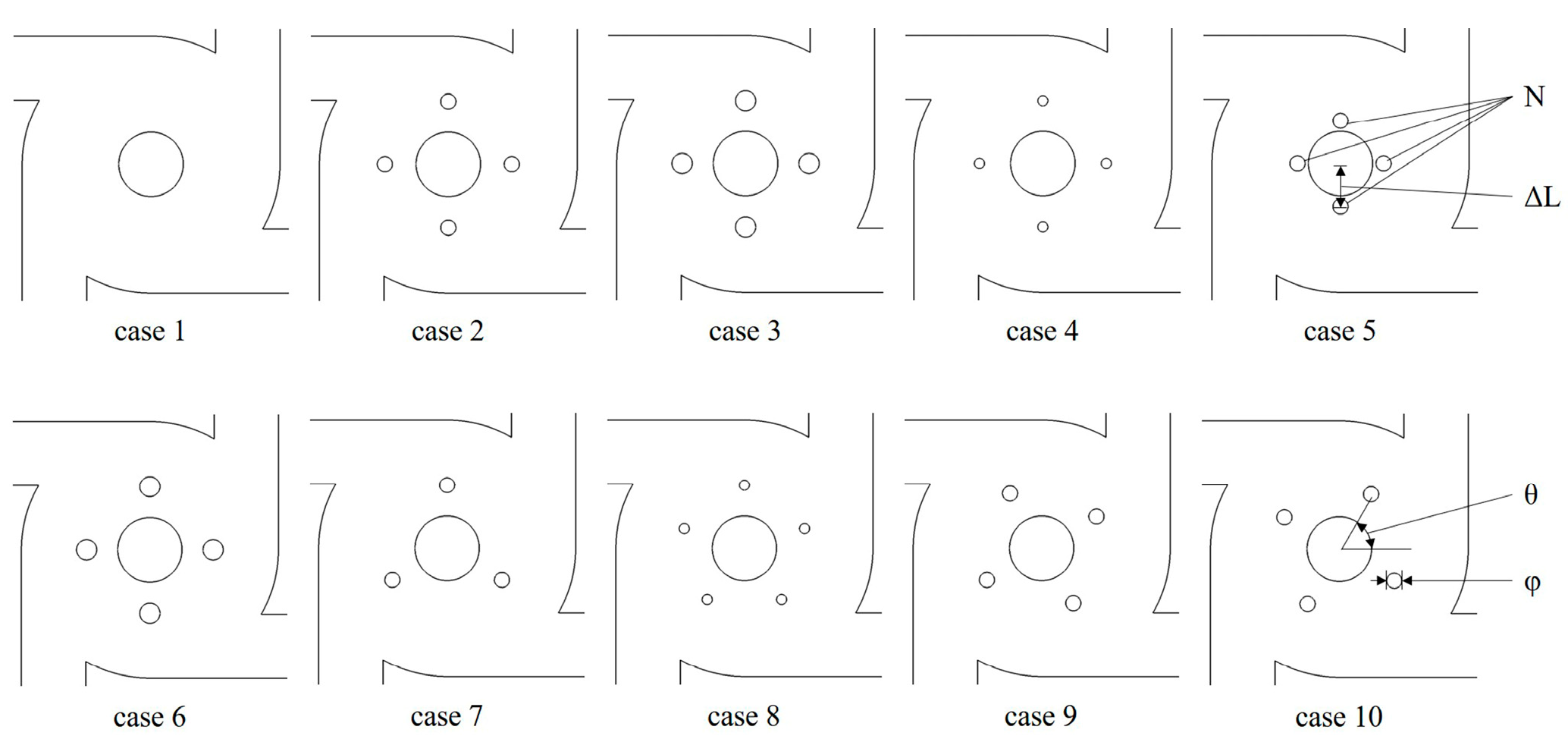

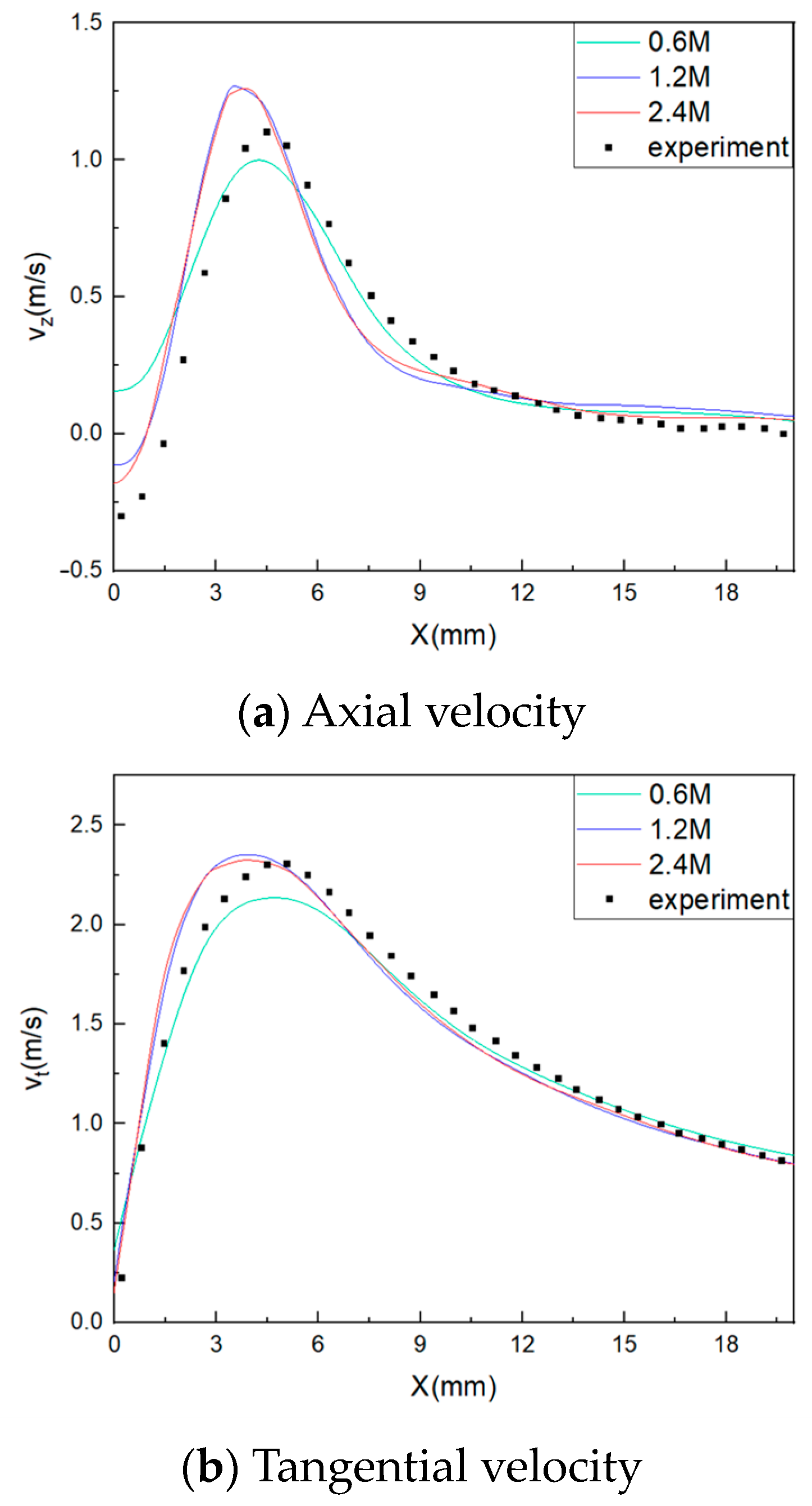
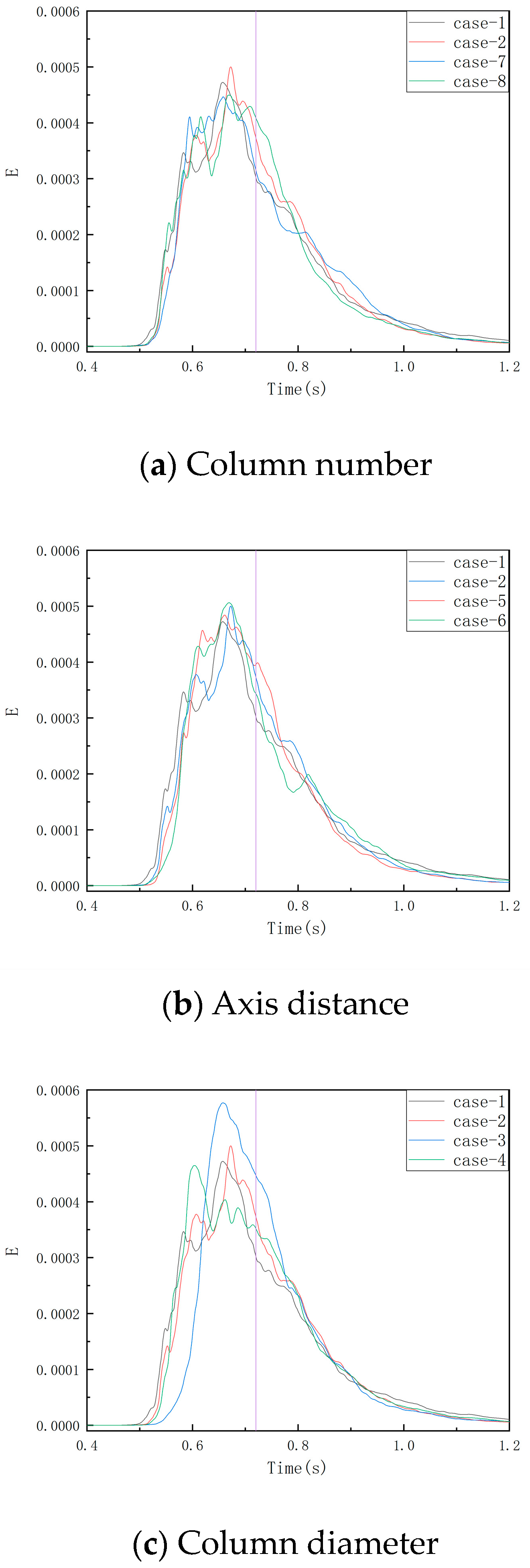


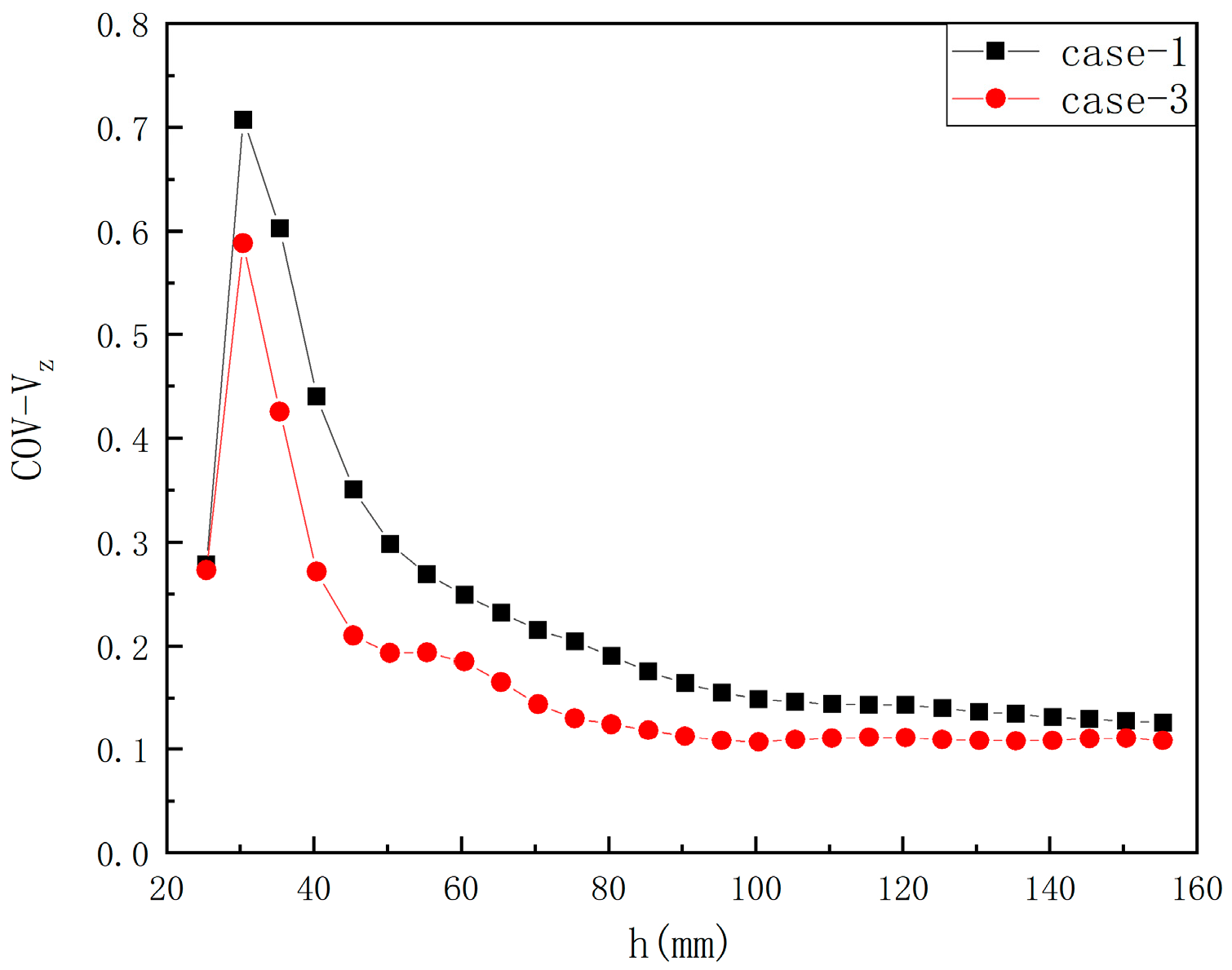

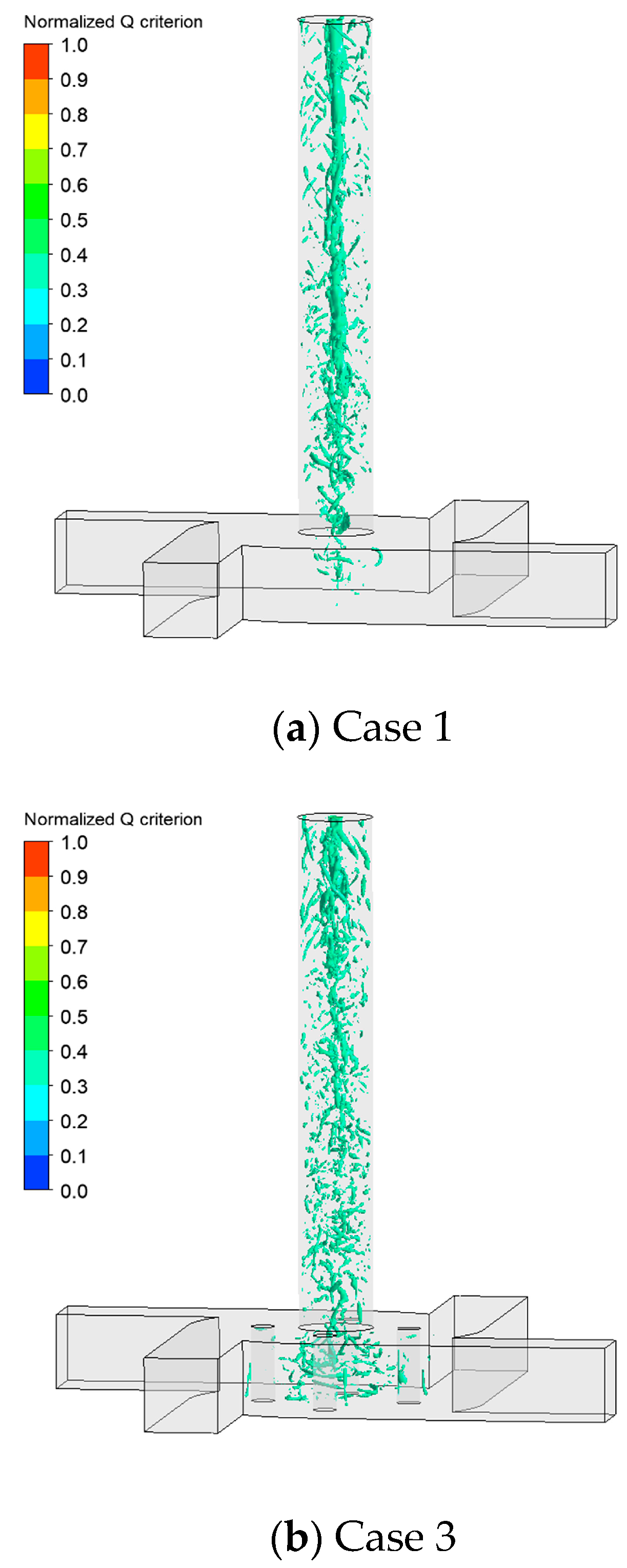
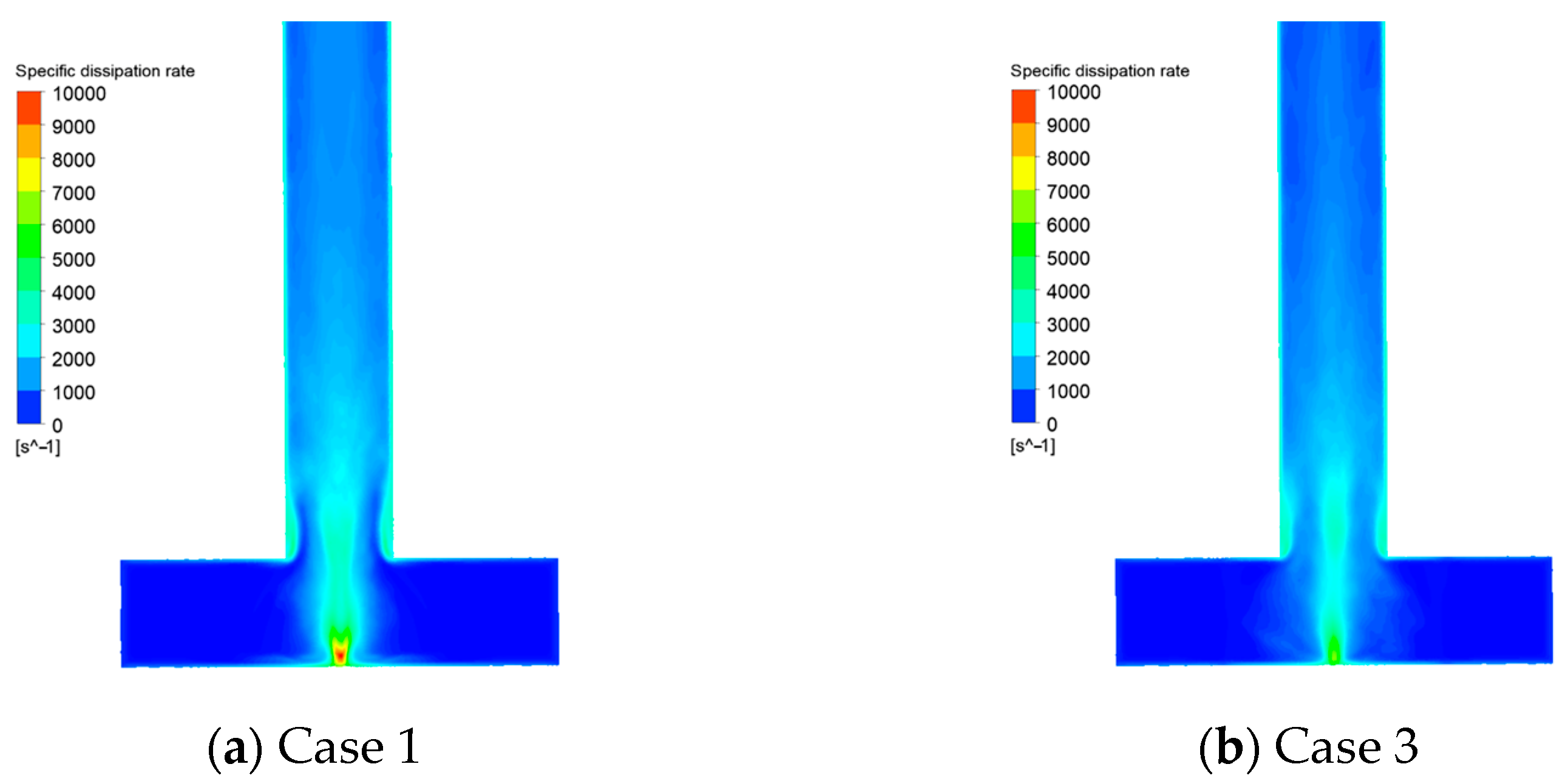
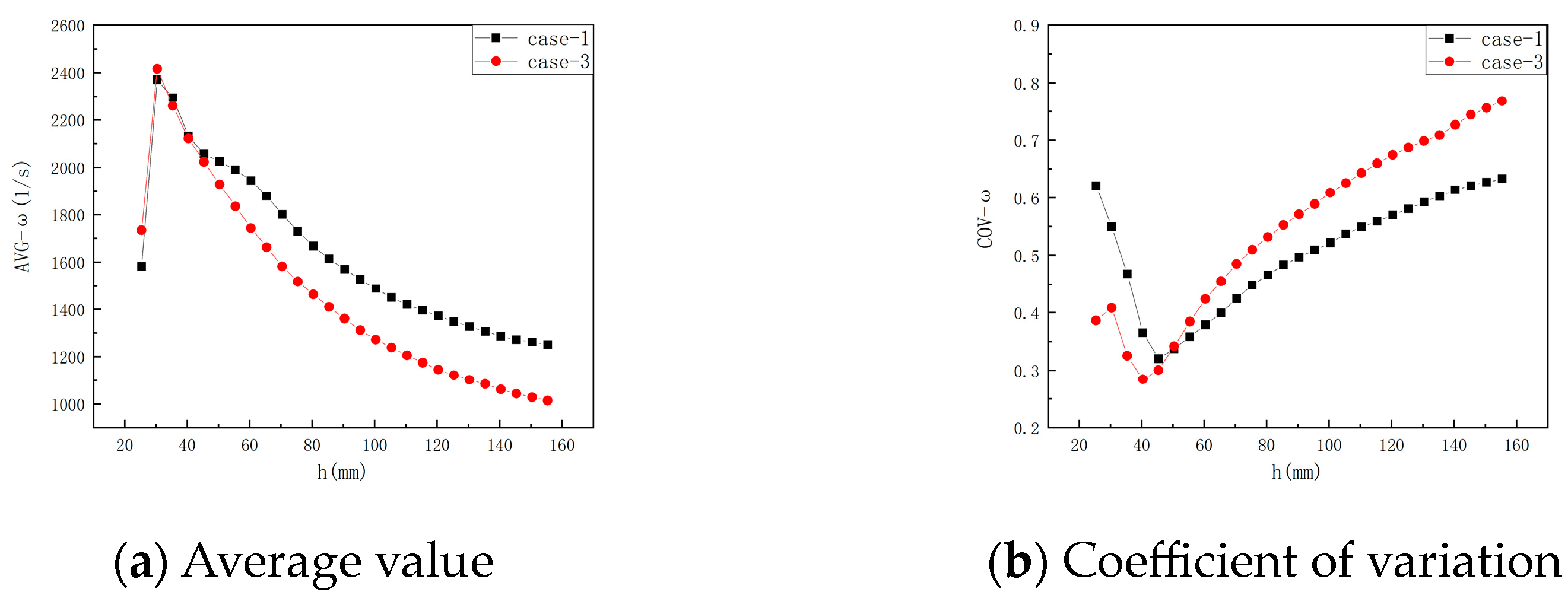
| Material | Density (kg/m3) | Viscosity (kg/m-s) |
|---|---|---|
| Water | 998.2 | 0.0009556 |
| Case No. | 1 | 2 | 3 | 4 | 5 | 6 | 7 | 8 | 9 | 10 |
|---|---|---|---|---|---|---|---|---|---|---|
| Column number, N | / | 4 | 4 | 4 | 4 | 4 | 3 | 5 | 4 | 4 |
| Axis distance (mm), ΔL | / | 3 | 4 | 2 | 3 | 3 | 3 | 3 | 3 | 3 |
| Column diameter (mm), φ | / | 25 | 25 | 25 | 17 | 33 | 25 | 25 | 25 | 25 |
| Rotation angle (°), θ | / | / | / | / | / | / | / | / | 30 | 60 |
| Case No. | 1 | 2 | 3 | 4 | 5 | 6 | 7 | 8 | 9 | 10 |
|---|---|---|---|---|---|---|---|---|---|---|
| Number of peaks | 4 | 5 | 1 | 4 | 6 | 4 | 6 | 6 | 6 | 4 |
| Case No. | 1 | 2 | 3 | 4 | 5 | 6 | 7 | 8 | 9 | 10 |
|---|---|---|---|---|---|---|---|---|---|---|
| Average residence time (s) | 0.722 | 0.722 | 0.732 | 0.720 | 0.717 | 0.728 | 0.726 | 0.716 | 0.712 | 0.719 |
| Variance | 0.0163 | 0.0134 | 0.0108 | 0.0143 | 0.0123 | 0.0149 | 0.0149 | 0.0135 | 0.0153 | 0.0141 |
| Dimensionless variance | 0.0313 | 0.0256 | 0.0202 | 0.0276 | 0.0238 | 0.0282 | 0.0283 | 0.0264 | 0.0302 | 0.0273 |
| Equivalent number of mixers | 31.9 | 39.0 | 49.6 | 36.3 | 41.9 | 35.5 | 35.3 | 37.8 | 33.1 | 36.6 |
Disclaimer/Publisher’s Note: The statements, opinions and data contained in all publications are solely those of the individual author(s) and contributor(s) and not of MDPI and/or the editor(s). MDPI and/or the editor(s) disclaim responsibility for any injury to people or property resulting from any ideas, methods, instructions or products referred to in the content. |
© 2024 by the authors. Licensee MDPI, Basel, Switzerland. This article is an open access article distributed under the terms and conditions of the Creative Commons Attribution (CC BY) license (https://creativecommons.org/licenses/by/4.0/).
Share and Cite
Peng, H.; Li, Z.; Cai, Z.; Gao, Z. Study of a Novel Method to Weaken the Backmixing in a Multi-Inlet Vortex Mixer. Processes 2024, 12, 476. https://doi.org/10.3390/pr12030476
Peng H, Li Z, Cai Z, Gao Z. Study of a Novel Method to Weaken the Backmixing in a Multi-Inlet Vortex Mixer. Processes. 2024; 12(3):476. https://doi.org/10.3390/pr12030476
Chicago/Turabian StylePeng, Han, Zhipeng Li, Ziqi Cai, and Zhengming Gao. 2024. "Study of a Novel Method to Weaken the Backmixing in a Multi-Inlet Vortex Mixer" Processes 12, no. 3: 476. https://doi.org/10.3390/pr12030476
APA StylePeng, H., Li, Z., Cai, Z., & Gao, Z. (2024). Study of a Novel Method to Weaken the Backmixing in a Multi-Inlet Vortex Mixer. Processes, 12(3), 476. https://doi.org/10.3390/pr12030476






